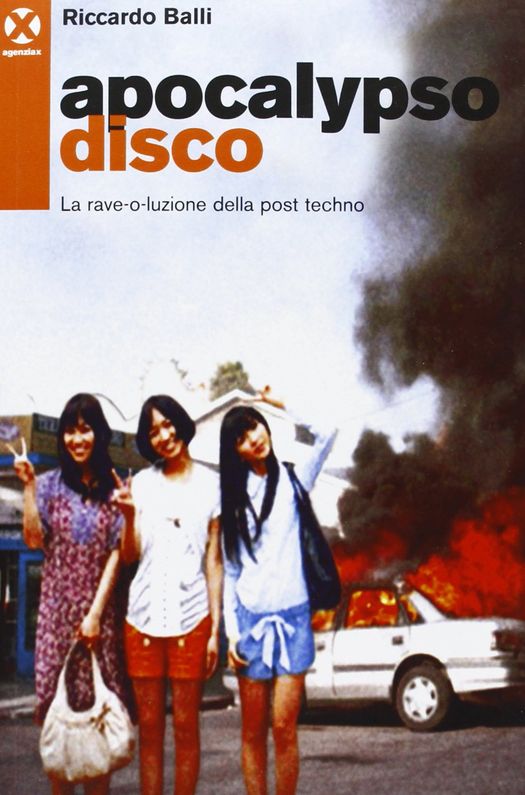
How to Cure a Gabba
Independent Researcher (Italy)
DOI: 10.12801/1947-5403.2014.06.02.12
The following is a chapter translation from my book Apocalypso Disco: La Rave-o-luzione della Post Techno (published in Italian in 2013 by Agenzia X), a collection of non-fiction, “literary remix”, fiction and interviews featuring key post-rave scenes: from break-core, to speed-core, to mash-up, to mutant dance floor, to psytrance, to 8 bit and to, of course, gabba, as you can read below.

Figure 1. Cover of Apocalypso Disco: La Rave-o-luzione della Post Techno by Riccardo Balli.
Such crude exhibitionism, machismo and warmongering spirit is, at the end of the day, absolutely consistent with the tender affection of the bear: the more ferocious it appears on the outside, the more sweet and squishy it is on the inside (at least in relation to the other members of the Thunderdome gang). This is actually the root of the term gabber (pronounced gabba), which comes from the Dutch slang equivalent for “mate”, “geezer” or even better, “oaf”—a big friendly giant who’s a little bit stupid. On the subject of stupidity, I believe that idiocy for its own sake is the cornerstone of every subculture, since idiocy creates a rupture within the dominant culture. All of those rituals typically performed amongst people who belong, ideologically, to a certain scene or subculture employ an element of tribal stupidity (the punk moshpit, the hardcore stagedive, the metal headbang, to name a few). But at the same time these rituals represent fantastic, revolutionary possibilities. Gabber, with its international Hakken dance and the specifically Italian phenomenon of the hardcore warrior human pyramid, has granted humanity with some of the most distinctive and exceptional idiots that any counterculture can recall.

Figure 2. Gabber Pyramid. Photo Credit: Number One (2014).
The hardcore warriors are a stylistic variation (still dancing to 180BPM!) that emerged exclusively in Italy, distinguished by crazy coloured mohawks instead of shaven heads, by cyber apparel such as studded collars, fluorescent leggings, flashy tight tank-tops and face painting, colliding, even physically, with the gabba mother-culture. The human pyramid is specifically their ritual. It started at the end of the night in Sala 2, a room originally dedicated to metal, at Number One, a club in Cortefranca (Brescia). After the locals had converted to techno, the heavy-metal moshpit continued and by 2000 the ritual had transformed into a human tangle in which hardcore warriors clambered on top of each other to construct a monolith: the first to climb to the top of the pyramid and touch the ceiling was crowned emperor of the gabba kingdom. The gabber dance, called “hakken”, is characterized by a series of rapid movements and jittery leg kicks to the pulse of the speakers, which could reach up to speeds of 190BPM. The origin of this dance is unknown. Possibly, it is a distorted version of the dancing performed in The Prodigy’s Out of Space, whilst the name might come from the slogan “hakkûh!”, coined by one of the pioneers of the genre, Dark Raver. In this dance, the moves hit every beat in quick succession, without cease; arms and hips are less important and respond to other musical elements.
Hardly anything has been written, said or debated about gabber, especially in Italy. However, in Holland, the birthplace of this phenomenon, they even have a weekly radio show dedicated to it called Hakkuuuh!?! on the network TMF, the Dutch version of MTV. Yet outside of the Netherlands gabba has been snubbed for its superficiality and machismo. These latter, undoubtedly, essential components of this nihilistic subcultural movement which has no ideological vision other than Londsale sweatshirts, Australian tracksuits, Nike classics and extreme facial piercings. But let’s be clear: the gabber look is truly beyond fashion, not because it is beautiful or ugly, but because it shows a synthetic posthuman aesthetic that looks even more extreme on women. In fact, watching a cute teenage girl with a platinum-blonde spiky fringe, fluorescent yellow zip-up BSA hoodie, furry woolen legwarmers on her ankles and purple Buffalos, goosestepping a Nazi salute at 200BPM on the dancefloor is undoubtedly weird. But this has little to do with politics, at least in the traditional sense. Fascism, if exposed (and this is not something you can take for granted, as someone might think when talking about hardcore techno), is exemplified by dance moves and behavior in the same way in which a new piercing between the eyeballs is exhibited. What remains is an immense ignorance (and this is where the subject becomes political) as a result of post-industrial alienation which reveals, especially during their spare time, aspects of total phallocentric control by the market. Radical hedonistic apathy and a no-future mindset encapsulate the movement, meaning that there’s a real risk that someone might kick the bucket during Global Hardcore Nation from too much reckless pill-taking.
The first wave of gabber rose from the ashes of hard house, in the early nineties, in Rotterdam, around Den Hag and partially in Amsterdam, from a sound inspired by hedonistic elements, distinguished by a 4/4 tempo at 140BPM with melodic contrapuntal synth-leads accompanied by soul vocal samples, in which their only purpose was to find the most effective form of entertainment. Such simplicity was certainly one of the seeds planted by the Nazis to let their ideology take root, as Wilhelm Reich observed highlighting elementarity as one of its main features: “Speeches in National Socialist meetings were indeed characterized by very clever manipulations of the emotions of the mass individuals and by strict avoidance of objective argumentation” (1946: 28). Similarly, the gabba of Neophyte or Paul Elstak is churned out for the superficial hedonism of the Dutch crowds of the 80s and 90s, a mecca of illegality (prostitution, free drugs, etc.) and, of course, avoids any kind of complex or experimental sonic reasoning. Sticking with this comparison, the indissoluble bond between blood and the dance floor is the indispensable precondition for the life of the gabber nation. 4/4 at 180BPM is an inalienable hereditary right of the Thunderdome rural lineage. And we could continue down this road of dystopian analogy, but this will leave us with nothing more than the intellectual pleasure of hyperbolic comparison, an exaggerated provocation for its own sake—just like the warmongering and xenophobic posturing of the gabbers. Pointless to pigeonhole them with something other than a generic youthful deviance fueled by the ignorance and apathy of a Eurotechnocentric banlieue. At the end of the day, some seminal producers of the genre are black, like the previously mentioned Dark Raver, not to mention the English Loftgroover. Sticking to the realm of speedcore, there is also a German historical project active from 1993 called ANC (Anti Nazi Core) and the techno hardcore label, Mokum, famous for the slogan: HARDCORE UNITED AGAINST RACISM AND FASCISM.

Figure 3. Hardcore United, from Mokum 12” sleeve. Photo credit: Mokum (1997).
The list could go on, but I think it’s enough to dispel the stereotype. Certainly there are some militant neo-fascists. But who knows the self-declared Dutch National Socialist Panzerfaust? Has anyone heard the spineless anthems White Revolution 2009/Whitecore 2009, Radical Islam Plague of the World or Aryan Techno, in which the usual bumbum beat is cut with vintage recordings of Nazi hierarchs? Originality is not the driving force even in Ah ah ah de Antifa or in his vindictive comeback Gabber United Against Antifa. This is music of staggering banality, not known in the gabba scene.
Returning to our history, gabber, springing from the hedonistic sound of the phallocentric market, has since faced, particularly in the city of Rotterdam with producers like Speriminator and Euromasters, a process of lumpenproletarianization, much like oi! in the punk scene. Eliminate the melodic synth lines and certain hardcore vocalisms and you’re left with frenetic beats at 190BPM, recalling the alienating repetition of the machines on an assembly line. According to the Australian label-owner Mark Newlands from the legendary Bloody Fist Records: “In Newcastle most of the people involved there are related to someone who works in industry or something like that, maybe that a subconscious effect on their material” (Datacide Magazine 1997). Techno hardcore, topped up with urban noise, industrial sounds and dark atmospherics, also carves out a sonic profile of revolutionary agitprop, becoming a soundtrack for the most deviant underclasses of Europe and Australia. But beware: if the accusations of nazism make little sense, the same applies to possible militant components of the sound. A gabber mohawk, spiked or dyed, will never be comparable to a traditional punk mohawk: the gabba mohawk is in fact nothing more than a gadget, like a Fred Perry shirt. They have no ideological connotations. In a tragically indifferent sense it is simply a decoration, full stop. If I had referred earlier to how weird it is to see a little 17 year old gabber chick working on her hakken dance, it is no less frustrating to see an attribute of a member of another subculture, like the mohawk of a hardcore warrior, cracking out the Thunderdome dance at high velocity, without pause, kicking every beat!

Figure 4. Hardcore Warrior. Photo Credit: Number One (2014).
This is pure gabba-emptied-of-content, under the banner of a hedonism for sale at the merch-stall at a mega rave. In this sense, the contribution of labels like Hangar Liquides Records and Praxis Records or artists like Ilsa Gold and Laurent Ho should be considered as an experimental virus in the vast sea of techno hardcore, a more engagé incarnation of the genre. I realize that I am leading into types of music, such as speedcore, fleshcore and extratone, which have developed identities of their own.
Let’s return instead to gabber and its nihilists, stubborn followers and social deviants who should not be ghettoized or labeled with any ideological definition, but critically discussed and reterritorialized from the inside. I have played at gabber/industrial events (the boundary between the two is often blurred in Italy) in which my hyperkinetic breaks and distorted frequencies were enthusiastically welcomed by the shaven heads with wild moshpits or complements like: “Nice one mate, TUUUUUUUNNNNE!” Such pure ignorance has much subversive potential. Maybe it's a matter of adapting it to the right channel. If dancing by the decks there's a 4/4 “Duce” freaking out to speedcore beats, instead of following Antifa orthodoxy and smashing his head by default, another revolutionary strategy can be considered: find an extreme music connection with him in order to subvert his mind. The alleged gabber-fascism in Italy is, in fact, a chauvinistic behaviour disorder, a symptom of gang ignorance and late-capitalist alienation. It can be treated as a psychopathology on the dance floor. Help them redirect their transgressive energy into the right channel, look them in the eye, as close as their eyebrow piercings, and whisper into their ears words that might reawaken their critical faculties. Our task is to develop paradoxical rhythmic strategies of music therapy that will puncture their arrogant security, as well as free the gabba imaginary from the prisons of Lonsdale, Australian etc. In reality, I am not sure if such a cure is possible on such a grand scale, allopathically confronting melodic synth-lines with postindustrial distortion or hardhouse vocal samples with samples from extreme films and so on. The “audio cure” can only be divisive, contagious and homeopathic. Divisive: the physician should actually experiment with his curative models of behaviour on himself first. He should not enter into an oppositional game. In practice this means completely absorbing himself into the gabber sonic universe, getting through the complete discography of Marc Acardipane aka PCP from Frankfurt, through to the UK hardcore of the Deathchant rec. rooster, the happy hardcore of Scooter, distinguished by his lyrics that are beyond insanity, and the Japanese gabber by DJ Sharpnel, in order to decode the audio dynamics of the Thunderdome brain. Contagious in the sense of being able to modify other cells through imitation and not imposition. Transferring this to music would mean implanting the virus through listening to a variety of extreme genres from speedcore to breakcore, in order to propagate the infection within the gabba organism.
The beat has to be as broken up as much as possible: we must create an alchemy of rhythm and a backbeat that favors hyperkinetic, multidirectional movements. Developing this paradoxical motor technique will make it easier to question the dogma and intellectual sclerosis consolidated by many years of 4/4 beats and 180BPM. The gabber engaged in hakken footwork will wreck the floor hampered by breaks, maintaining balance by establishing a schizo-motor state, as if taken by a sudden epileptic seizure. Eventually, after this necessary exercise, the detoxified gabba will enjoy black Africa and broken beats!
Bass is gastroenterological music.
It speaks directly to the intestine, duodenum, pancreas, colon and rectum. The digestive system is in fact most receptive to bass cut-off frequencies that churn through the stomach like a cyst. The gabber, after the first inevitable esophageal reaction to an unconventional bass line, will start to appreciate its succulent flow and wobble until he discards his perennial constipation medication and no longer expels bass from his arse.
As a novice watercolorist, the gabber in a beret, palette in one hand, brush in the other, will, blowing on his vuvuzela, paint still life images: industrial landscapes, garbage dumps and mutants. Deftly applying a little bit of grey (noise) and then a bit of pink (noise) will bring a bit of industrial chromatic sensitivity to the canvas-track. Departing from the black and white of 4/4 kicks will help him discover a whole new world in which white (noise), brown (noise) and purple (noise) are the protagonists.
We have already discussed[1] the synesthetic affects of music and how through the use of a wide range of possible frequencies you can create feelings that move beyond the audible and arrive at the tactile.
With certain high-pitched synth-lines from the most extreme drum’n’bass, these dynamics become imperceptible. Sounds get beneath the skin. Hearing no longer perceives these high-pitches so that sound makes the skin listen. You feel those goosebumps as it gets cold. The music is actually cold, since the skin has lowered its temperature by at least one degree due to the radical distortion of the frequencies.
Time in music is radically different from time in the late-capitalist metropolis, which consumes everyday life. Musical duration is only measurable in terms of sensibility, tension and emotion. As noted for the first time by Benjamin, the attempt to blow up the continuum of history is a typical revolutionary act: every revolution begins with a transformation of time. During the French Revolution, when night fell on the first day of battle, the revolutionaries independently shot all the clocks of the bell towers across Paris simultaneously.
The intelligence of the gabber must be tested through complex concepts, like sonic déjà vu. This term refers to a sonorous experience of memoire involontaire. It involves enriching tracks with samples that are buried in the collective-media-consciousness, which, once awake, like Zombies on the march, begin to operate the gabber brain, (previously) inactive from too many chemicals. Of particular use might be old TV jingles or theme songs we’ve heard hundreds of times that won’t leave us alone until we can identify them: audio-proustian madeleines that open up worlds through involuntary memory.
Through mixing with the most absurd genres we can instill a serious identity crisis in the gabber, who will end up with an ineluctable emancipatory schizo-rhythm against all the psychopathological problems of the subject. It’s always him, the hardcore warrior, storming the middle of the dance foor with the rage that only a shaven skull can provide. When you first overlay the usual BUM BUM BUM in the beatmix and cut it with the melody of an Hawaiian ukulele, recalling a dreamy maritime Eden with flower necklaces, there he is: the moshing tiki-gabber. This is only a clinical example of the fracturing of the musical-behavioural brainframe. We might also mention other medical literature on the subject, such as the famous afro-ebm, a rather simplified drum machine which contaminates industrial rhythms with intricate percussive sounds from the black continent, and so on, forever, breaking the water-tight compartments of psycho-musical genres.
Riccardo Balli is a DJ/producer, active in the label Sonic Belligeranza <http://belligeranza.c8.com>. He is the author of several books in Italian about countercultures, including Anche Tu Astronauta (Castelvecchi, 1998) and Apocalypso Disco (Agenzia X, 2013). He contributes to Datacide Magazine.
Benjamin, Walter. 1968. Illuminations. Trans. H. Zohn. New York : Schocken Books.
Berardi, Franco. 1993. Come si cura il Nazi. Roma: Castelvecchi.
Datacide Magazine. 1997. London. “Interview with Mark Newlands / Bloody-Fist”. <http://datacide.c8.com/interview-with-mark-newlands-bloody-fist/>.
Reich, Wilhelm. 1946 [1933]. The Mass Psychology of Fascism. Trans. T.P. Wolfe. New York : Orgone Institute Press.
Thanks to Roberta Bononi for the gabba vision, Oliver Evans and Alessandro Ceccarelli.
[1] Earlier in the book from which this chapter was translated I discussed the synesthetic affects of music and how through the use of a wide range of possible frequencies you can create feelings that move beyond the audible and arrive at the tactile.